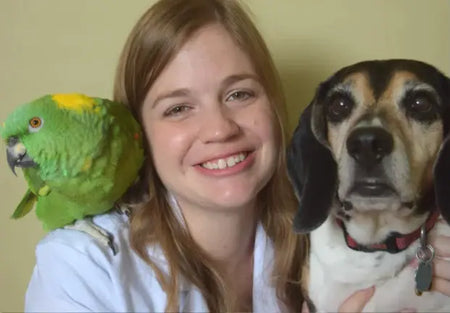In This Article
You are what you eat!
The poultry production industry has used probiotics for decades. Poultry production focuses on optimal growth rates, immune health maintenance, and a good feed conversion ratio. From a production standpoint, it is much easier to prevent disease than treat it. A study examining chickens exposed to pathogenic E.coli found that the group supplemented with a probiotic showed improved growth performance and a lower mortality rate (1). In another poultry study, probiotics were shown to aid in the prevention of the colonization of pathogenic bacteria such as Salmonella and Clostridium difficile (C.diff) by competing for adhesion to the GI epithelium (2).

How does this relate to our companion birds?
Companion parrots are not considered domesticated animals. In fact, they are very closely related to their wild counterparts. However, some of the more prominent differences between companion parrots and wild parrots can be found in their guts. How does the microbiome of companion parrots differ from their wild counterparts? One study evaluated the normal intestinal microbiome of wild parrots compared to captive parrots and found that there were significant differences in the types of bacteria comprising the microbiome of the two populations. It was also noted that the wild population of parrots had a less diverse microbiome when compared to the captive parrots (3). Both studies in poultry as well as in captive parrots indicate there is a higher prevalence of Lactobacilli and other gram-positive bacteria that comprise the microbiome. Another study examining cockatiel chicks given isolates of Lactobacillus salivarius isolated from adult cockatiel crops determined that there was a significant improvement in the growth rate of chicks and a reduction of gram-negative bacterial organisms (4).
Determining avian health is not always obvious:
Several factors affect the microbiome of companion birds which include: age, diet, environment, immune status, and current medications. Birds are masters at hiding illness. When presented with a sick bird in veterinary practice, we often find the animal has been unwell for a few days but only started displaying clinical signs of illness shortly before the visit. The avian gastrointestinal tract is sometimes primarily or secondarily affected depending on the illness.
One study examined the effects of Macrorhabdus ornithogaster infections, an opportunistic yeast, in canaries. While there is not a lot known about the diversity of the microbiome in avian species, it determined that the group affected with the opportunistic yeast had less diversity than the uninfected group. In previous studies, they noted that infection with Macrorhabdus initiates an inflammatory response in the proventriculus, the glandular portion of the avian stomach, which ultimately leads to gastritis. Gastritis causes a reduction in normal gastric acid production and therefore an increased pH.
This increased pH due to reduced acid production allows survival and proliferation of microbes that wouldn't typically be present and causes dysbiosis (5). As several studies in poultry have indicated, the microbiome plays a vital role in the immune system, growth rate, and maintaining overall health status. Probiotics have the potential to be very helpful in our companion avian population.
While it is impossible to characterize the microbiome for every individual avian species, considering the unique features of the avian GI tract, further classifying the microbiome, and studying the mechanisms in which it affects the immune system may prove very beneficial in the treatment of various diseases as well as improved overall health for our companion birds in the future.
Sources
- Tarabees, Reda et al. “Effects of Dietary Supplementation of Probiotic Mix and Prebiotic on Growth Performance, Cecal Microbiota Composition, and Protection Against Escherichia Coli O78 in Broiler Chickens.” Probiotics and Antimicrobial Proteins, vol. 11, no. 3, 2018, pp. 981–89. Crossref, doi:10.1007/s12602-018-9459-y.
- Clavijo, Viviana, et al. “The Gastrointestinal Microbiome and Its Association with the Control of Pathogens in Broiler Chicken Production: A Review.” Poultry Science, vol. 97, no. 3, 2018, pp. 1006–21. Crossref, doi:10.3382/ps/pex359.
- Xenoulis, Panagiotis G., et al. “Molecular Characterization of the Cloacal Microbiota of Wild and Captive Parrots.” Veterinary Microbiology, vol. 146, no. 3–4, 2010, pp. 320–25. Crossref, doi:10.1016/j.vetmic.2010.05.024.
- Smith, Jeanne Marie. “A Review of Avian Probiotics.” Journal of Avian Medicine and Surgery, vol. 28, no. 2, 2014, pp. 87–94. Crossref, doi:10.1647/2012-031.
- Robino, Patrizia, et al. “Changes in Gut Bacterial Communities in Canaries Infected by Macrorhabdus Ornithogaster.” Avian Pathology, vol. 48, no. 2, 2018, pp. 111–20. Crossref, doi:10.1080/03079457.2018.1553294.


